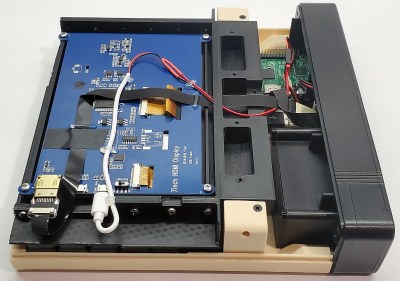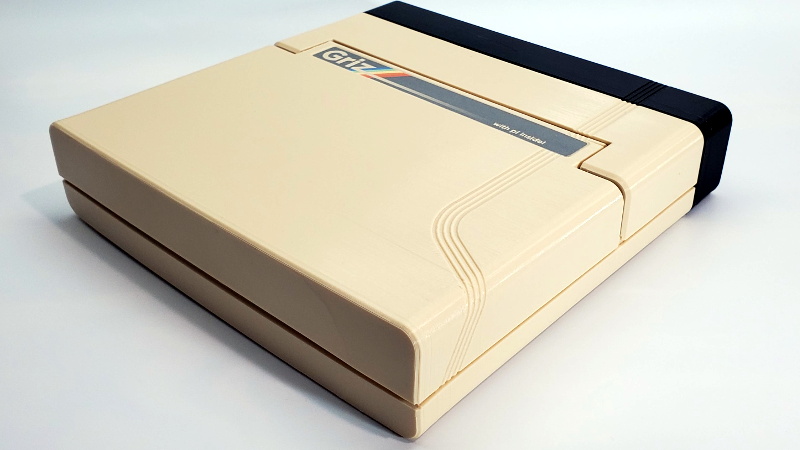If you’re familiar with vintage portable computers, you know about the GRiD Compass. Even if you’re not into computers of yesteryear, there’s a good chance you’ve seen a Compass or two without realizing it. From battling xenomorphs in Aliens to making the trip to orbit aboard the Space Shuttle, the trendsetting clamshell computer seemed to be everywhere in the 1980s. While far too expensive for the average consumer to afford back then, its no-compromise design and sleek looks helped lay the groundwork for today’s ubiquitous laptops.
Getting your hands on a working GRiD Compass in 2021 isn’t a whole lot easier than it was in 1982, so [Mike] decided to do the next best thing and build his own. His GRIZ Sextant certainly isn’t a replica, but the family resemblance is strong enough to get the point across. The Raspberry Pi powered machine has a greatly reduced “trunk” section in the back as you might expect, but the overall layout is very similar. The Commodore 64 inspired color scheme is probably the biggest departure from the source material, but it’s hard to argue with the results.
 It’s clear at a glance that a lot of thought was put into the external aesthetics of the Sextant, but a peek under the hood shows the internal details are equally impressive. [Mike] tells us he has a background in product design, and it shows. Rather than approaching this project as a one-off creation, he’s clearly taken great pains to ensure the design is as reproducible as possible.
It’s clear at a glance that a lot of thought was put into the external aesthetics of the Sextant, but a peek under the hood shows the internal details are equally impressive. [Mike] tells us he has a background in product design, and it shows. Rather than approaching this project as a one-off creation, he’s clearly taken great pains to ensure the design is as reproducible as possible.
All of the individual components of the 3D printed frame and enclosure have been carefully designed so they’ll fit within the build volume of the average desktop machine. Electronic components are screwed, not glued, to the internal framework; making future repairs and maintenance much easier. When combined with the ample internal volume available, this modular approach should make adding custom hardware a relatively painless process as well.
So when will you be able to build a GRIZ Sextant of your own? Hopefully, very soon. [Mike] says he still needs to work some kinks out of the power supply and finalize how the speakers will get mounted into the case. Once those last tweaks are locked in, he plans to release all the STL files and a complete Bill of Materials. For those who want to get a sneak peek before they start warming up the extruder, he’s also started documenting the assembly of the Sextant on his YouTube channel.
Over the last few years, we’ve seen an incredible number of bespoke portables created by members of the community. From outlandish cyberdecks to labors of love like the Sextant that pay homage to the technology of decades past, ever more capable desktop 3D printers and Linux SBCs are finally allowing hackers to create the truly personal computers of their dreams.



















80’s are before my time, but I love the look. I might copy this form factor in the future.
This is quite an impressive build, both in design and in the 3D printing execution. I think you chose wisely, not including the kick stand. Many laptops today have completely laid-down-flat keyboards and I’m okay with that. In 1982, people still thought there was a good reason for angled keyboards.
Just one little, nagging thing, though: that escape key really ought to be purple.
38:49 min long video.
Who’s he kidding?
What’s the matter, attention span too short ?
I only have a 30 minute lunch hour.
So you actually have a lunch-half-hour.
Or is that half of a lunch hour?
No, problem is that there isn’t enough information in those 38 minutes to justify watching the whole thing. I usually watch videos I’m interested in to the end, but had to stop about half way through on this one because there wasn’t any clue that anything interesting remained. 38 minutes is ridiculous for a 3D printing project with five pieces.
“Almost there.” Garven Dreis, Red Leader.
For my druthers I’d have a handle, fully articulated screen (goes back almost flat) and the conventional staggered qwerty.
I like it a lot though, getting a place on my round tuit list.
Have to disagree with you on the staggered QWERTY. The sole reason for the stagger was so that the keybars would be evenly spaced. When was the last time you saw a typewriter? It takes almost zero time to get used to a keyboard using keys arranged in a regular grid without row offsets. QWERTY itself seems to have a certain utility, as many words switch back and forth between the left and right hands, and in general is not that hard to learn, but it’s time for the stagger to go away.
Nah, I’m using 5 different keyboards on the regular daily, all different sizes, strokes and spacing, and a dozen more on various occasions (Not counting virtual keyboards) and I have one non-staggered wireless one I bought over a year ago, and I cannot get used to it at all. It is the very bottom of the list, keyboard of last resort, and that list includes a $5 “dead flesh” rubber BT keyboard that is somewhere between a ZX81 and Spectrum in nastiness. (Timex 1000/2000)
You say it’s a totally mechanical issue of type writer design, I say that coincidentally or not, it’s also ergonomics, your fingers spread out when you straighten them and come closer together when you curl them in, leading naturally to angled rows.
*columns, rather.
Yes, a handle would be great. Possibly problematic, though. I once had a typewriter that had a fold-out handle that stowed under the keyboard, but since this was offset from the center of gravity, it tilted when carried such that the center of gravity was directly below the handle, of course, which in turn meant that the back end of it was closer to me than the handle, resulting in it banging against my leg whenever I carried it by the handle. So instead I usually carried it like a notebook.
I remember the distinctive ELD display which I believe was red on black.
A deep orange, almost red.
But then my eyes aren’t properly calibrated.
Absolutely gorgeous, can’t wait for release of files so I can spin up my own version.
Drooling over here. Came out gorgeous. Loves me some orange keys :)
I usually ignore everything Pi-related but this… I simply couldn’t. It is just too amazing.
Probably among the best homebrew ever made. Looking forward to seeing it released.
Here’s to Hoping It’s not another “I’ll release the files when it’s perfect!” Then never does.
Unless you plan to $$ it. Why not let the Community Contribute solutions.
My 1 cent.
Stand corrected. for future People who find this post here is the link to the files.
https://www.hackster.io/news/the-griz-sextant-is-a-raspberry-pi-cyberdeck-with-beautiful-80s-styling-b37d71284eae
Sweet, but if he’s using Commodore 64 “os” he should consider the Commodore LCD for his next revision.
https://www.c64-wiki.com/wiki/Commodore_LCD
Or actually produced hardware like the Commodore Oscilloscope Typewriter… I mean SX-64
I had one of those! And if he did make one since he’s using a Raspi he could but a pony keg in it!
Man what a beauty. Personally I would have done it black like the real GRID, but of course we’ll have the option of doing that when/if we actually get the files and can print our own. I do agree with the previous commenter that I would rather we have 98% complete STL files now than 100% ones sometime maybe-sorta in the future. But of course its his project and nobody can force him to put out something before he feels ready.
Okay, you SAY it was inspired by the Grid Compass, but it is almost identical to a Toshiba T1100, or a Tandy 600.
I had a 600 myself, and was surprised that it wasn’t more popular than it was. Probably the non-IBM compatibility thing. It was the perfect coffee shop computer, though, and with a strictly reflective STN black-on-green LCD screen, battery life was pretty damn good – around 6 hours the way I used it. It came with MS-BASIC in a socketed ROM, which could be swapped with a Multiplan spreadsheet ROM.
Yes a lot like many of the clamshell portables. I had an abused T1100 I picked up for pocket change in the 90s, but had to let it go in a move. HDD was totally screwed and they weren’t easy to find then. Just played a few DOS games off floppy on it, but it was a charming little bugger. Got a Sharp PC-4600, similar sort of shape, but heavier and more tankish. It’s bulk subtracts from it’s charm a bit. Seeing a Tandy 1100FD pop up on local listings, kinda tempted to make a play for that.
M3x8 awesome!
6-32 x 1-1/2″, wait, what?
Why not M3.5×40? Or M4? Or M3x40? Or x35?
I became sad at that point.
Probably because The Home Depot didn’t carry those. Many people in the U.S. would go all metric if they could, but it’s not easy. Most hardware stores carry metric screws, but not in the same range that they carry “freedom” screws. Which is kind of crazy since everything we buy from outside the U.S. is metric. Which is almost everything. Which is a different kind of sad. But thanks for reminding us that we look like yokels. And thanks, Reagan, for your help in this.
Don’t know if anyone here would be interested but there’s this channel on youtube called Retail Archaeology where the guy goes around to various dying/dead malls and some of those locations, like Neonopolis in Las Vegas, look like they’d be great locations for cyberpunk themed shortfilms or perhaps LARPing.